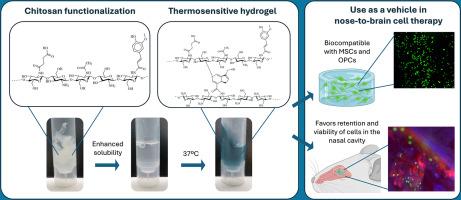Thermosensitive chitosan-based hydrogel: A vehicle for overcoming the limitations of nose-to-brain cell therapy
IF 9.4
1区 医学
Q1 ENGINEERING, BIOMEDICAL
引用次数: 0
Abstract
Cell therapy is a promising strategy for treating neurological pathologies but requires invasive methods to bypass the blood–brain barrier restrictions. The nose-to-brain route has been presented as a direct and less invasive alternative to access the brain. The primary limitations of this route are low retention in the olfactory epithelium and poor cell survival in the harsh conditions of the nasal cavity. Thus, using chitosan-based hydrogel as a vehicle is proposed in this work to overcome the limitations of nose-to-brain cell administration. The hydrogelʼs design was driven to achieve gelification in response to body temperature and a mucosa-interacting chemical structure biocompatible with cells. The hydrogel showed a < 30 min gelation time at 37 °C and >95 % biocompatibility with 2D and 3D cultures of mesenchymal stromal cells. Additionally, the viability, stability, and migration capacity of oligodendrocyte precursor cells (OPCs) within the hydrogel were maintained in vitro for up to 72 h. After the intranasal administration of the OPCs-containing hydrogel, histological analysis showed the presence of viable cells in the nasal cavity for up to 72 h post-administration in healthy athymic mice. These results demonstrate the hydrogel's capacity to increase the residence time in the nasal cavity while providing the cells with a favorable environment for their viability. This study presents for the first time the use of thermosensitive hydrogels in nose-to-brain cell therapy, opening the possibility of increasing the delivery efficiency in future approaches in translational medicine.
Statement of significance
This work highlights the potential of biomaterials, specifically hydrogels, in improving the effectiveness of cell therapy administered through the nose. The nose-to-brain route has been suggested as a non-invasive way to directly access the brain. However, delivering stem cells through this route poses a challenge since their viability must be preserved and cells can be swept away by nasal mucus. Earlier attempts at intranasal cell therapy have shown low efficiency, but still hold promise to the future. The hydrogels designed for this study can provide stem cells with a biocompatible environment and adhesion to the nasal atrium, easing the successful migration of viable cells to the brain.

热敏壳聚糖水凝胶:一种克服鼻脑细胞疗法局限性的载体。
细胞疗法是一种治疗神经系统疾病的有前途的策略,但需要采用侵入性方法绕过血脑屏障的限制。鼻入脑途径被认为是进入大脑的一种直接且创伤较小的替代方法。这种途径的主要局限是在嗅觉上皮中的保留率低,以及在鼻腔的恶劣条件下细胞存活率低。因此,本研究提出使用壳聚糖水凝胶作为载体,以克服从鼻腔到大脑的细胞给药的局限性。水凝胶的设计旨在实现随体温变化的凝胶化以及与细胞生物相容的粘膜相互作用化学结构。该水凝胶与间充质基质细胞二维和三维培养物的生物相容性达到 95%。此外,水凝胶中少突胶质前体细胞(OPC)的存活率、稳定性和迁移能力在体外可维持 72 小时。健康无胸腺小鼠经鼻内给药含有 OPCs 的水凝胶后,组织学分析表明给药后 72 小时内鼻腔内仍有存活细胞。这些结果表明,水凝胶能够延长在鼻腔中的停留时间,同时为细胞的存活提供有利环境。这项研究首次展示了热敏性水凝胶在鼻脑细胞疗法中的应用,为今后在转化医学中提高给药效率提供了可能。重要意义这项工作凸显了生物材料(尤其是水凝胶)在提高经鼻施用细胞疗法的有效性方面的潜力。鼻入脑途径被认为是直接进入大脑的非侵入性方法。然而,通过这种途径输送干细胞是一项挑战,因为必须保持干细胞的活力,而且细胞会被鼻涕冲走。早期的鼻内细胞疗法尝试显示效率较低,但仍有希望在未来实现。这项研究设计的水凝胶可为干细胞提供生物相容性环境,并使其粘附在鼻腔中庭,从而帮助有活力的细胞成功迁移到大脑。
本文章由计算机程序翻译,如有差异,请以英文原文为准。
求助全文
约1分钟内获得全文
求助全文
来源期刊

Acta Biomaterialia
工程技术-材料科学:生物材料
CiteScore
16.80
自引率
3.10%
发文量
776
审稿时长
30 days
期刊介绍:
Acta Biomaterialia is a monthly peer-reviewed scientific journal published by Elsevier. The journal was established in January 2005. The editor-in-chief is W.R. Wagner (University of Pittsburgh). The journal covers research in biomaterials science, including the interrelationship of biomaterial structure and function from macroscale to nanoscale. Topical coverage includes biomedical and biocompatible materials.
 求助内容:
求助内容: 应助结果提醒方式:
应助结果提醒方式:


